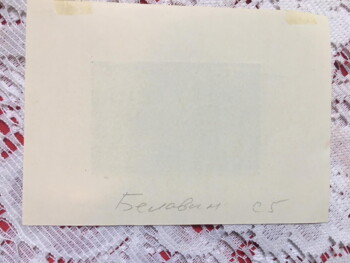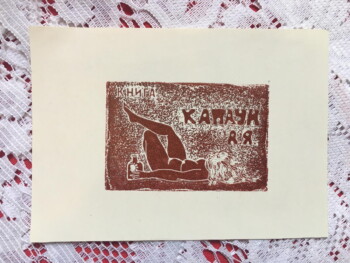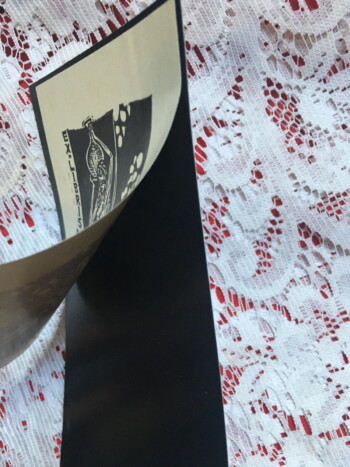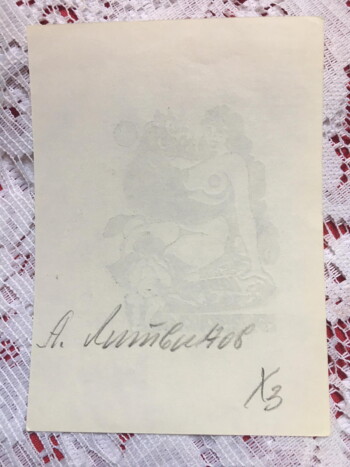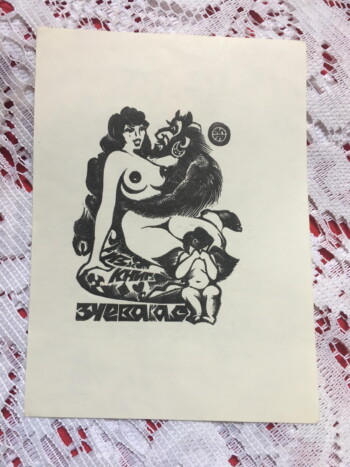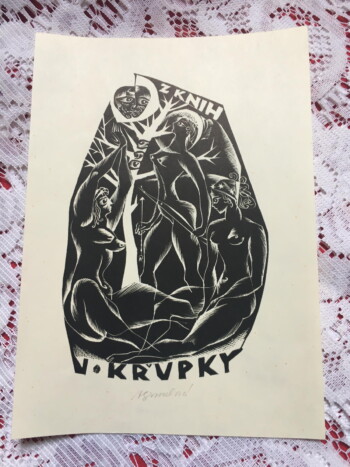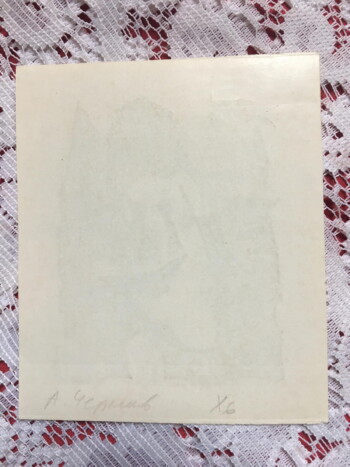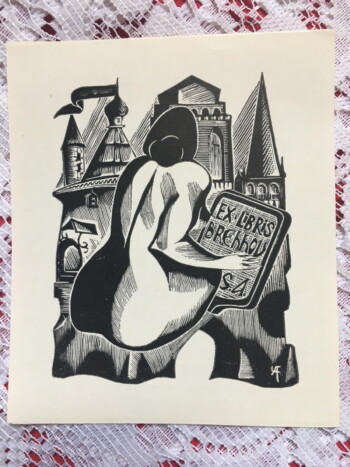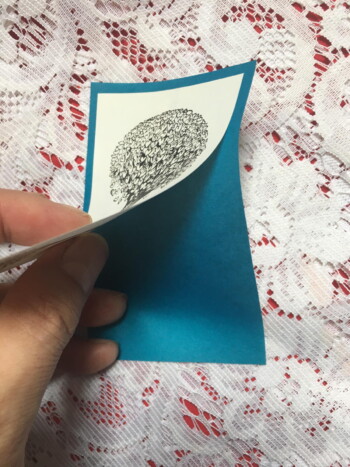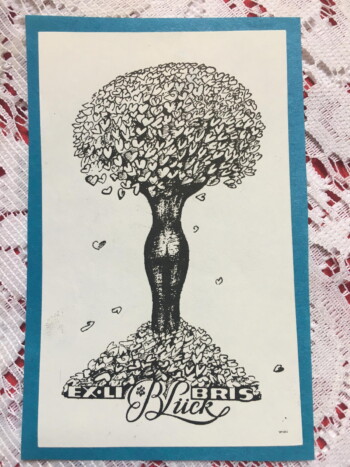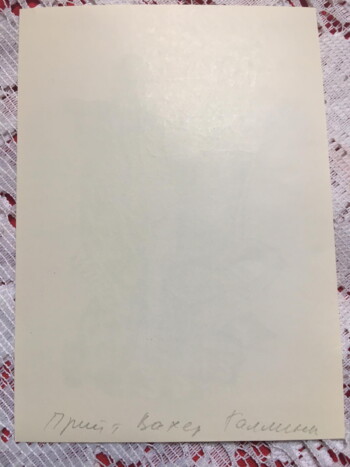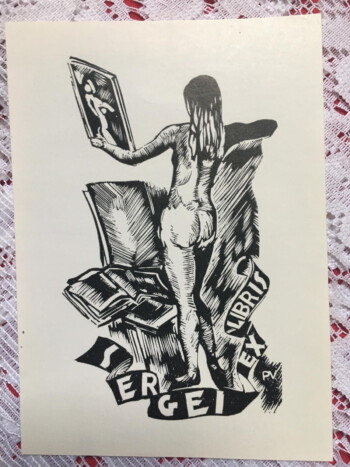-
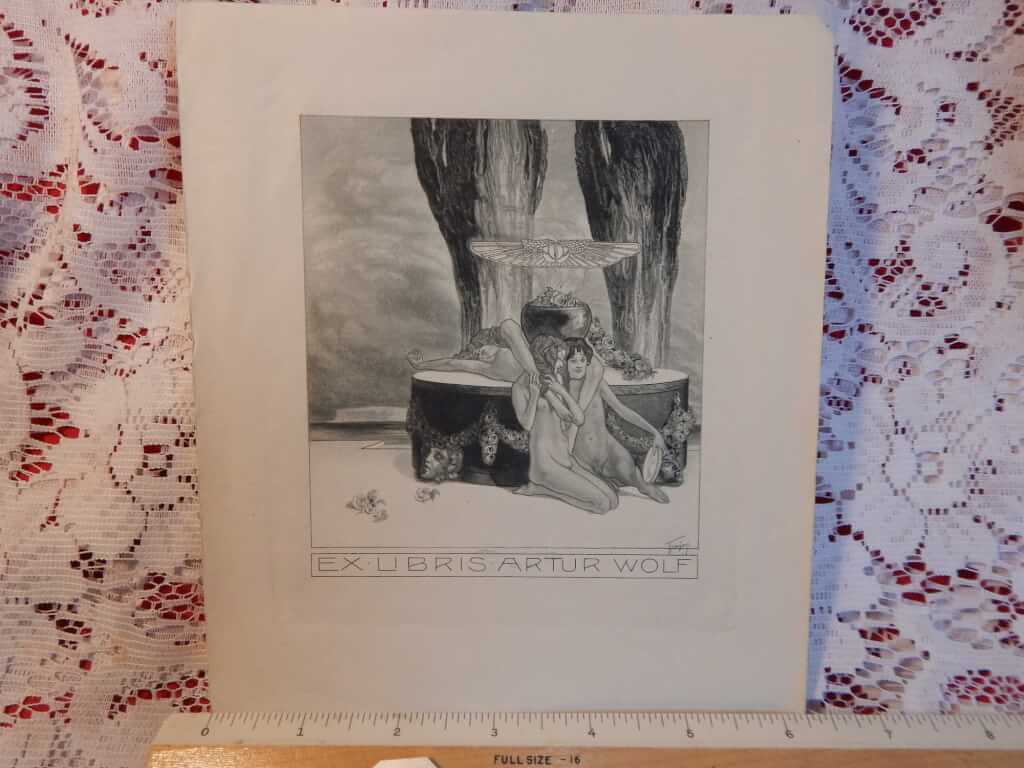 Ex Libris Artur Wolf, by Franz von Bayros paper size 6.25 x 7.25", print size 5 x 5.75", on hand laid paper three naked girls Franz von Bayros (1866 – 1924) was an Austrian commercial artist, illustrator, and painter, now he is best known for his erotic work. He belonged to the Decadent movement in art, often utilizing erotic themes and phantasmagoric imagery. At the age 17, Bayros passed the entrance exam for the Vienna Academy with Eduard von Engerth. Bayros mixed in elegant society and soon belonged to the circle of friends of Johann Straub, whose step daughter Alice he married on 1896. The next year, Bayros moved to Munich. In 1904, Bayros gave his first exhibition in Munich, which was a great success. From 1904 until 1908, Bayros traveled to Paris and Italy for his studies. Typically, for an artist dealing with such imagery, von Bayros produced work under several pseudonyms, most notably Choisy Le Conin, and was hounded by authorities for much of his life for his “indecent” art often very imaginative, and including such taboo subjects as sadomasochism and bestiality. He became equally well-known for his masterly drawn figures of elegant modestly nude and non-nude women.
Ex Libris Artur Wolf, by Franz von Bayros paper size 6.25 x 7.25", print size 5 x 5.75", on hand laid paper three naked girls Franz von Bayros (1866 – 1924) was an Austrian commercial artist, illustrator, and painter, now he is best known for his erotic work. He belonged to the Decadent movement in art, often utilizing erotic themes and phantasmagoric imagery. At the age 17, Bayros passed the entrance exam for the Vienna Academy with Eduard von Engerth. Bayros mixed in elegant society and soon belonged to the circle of friends of Johann Straub, whose step daughter Alice he married on 1896. The next year, Bayros moved to Munich. In 1904, Bayros gave his first exhibition in Munich, which was a great success. From 1904 until 1908, Bayros traveled to Paris and Italy for his studies. Typically, for an artist dealing with such imagery, von Bayros produced work under several pseudonyms, most notably Choisy Le Conin, and was hounded by authorities for much of his life for his “indecent” art often very imaginative, and including such taboo subjects as sadomasochism and bestiality. He became equally well-known for his masterly drawn figures of elegant modestly nude and non-nude women. -
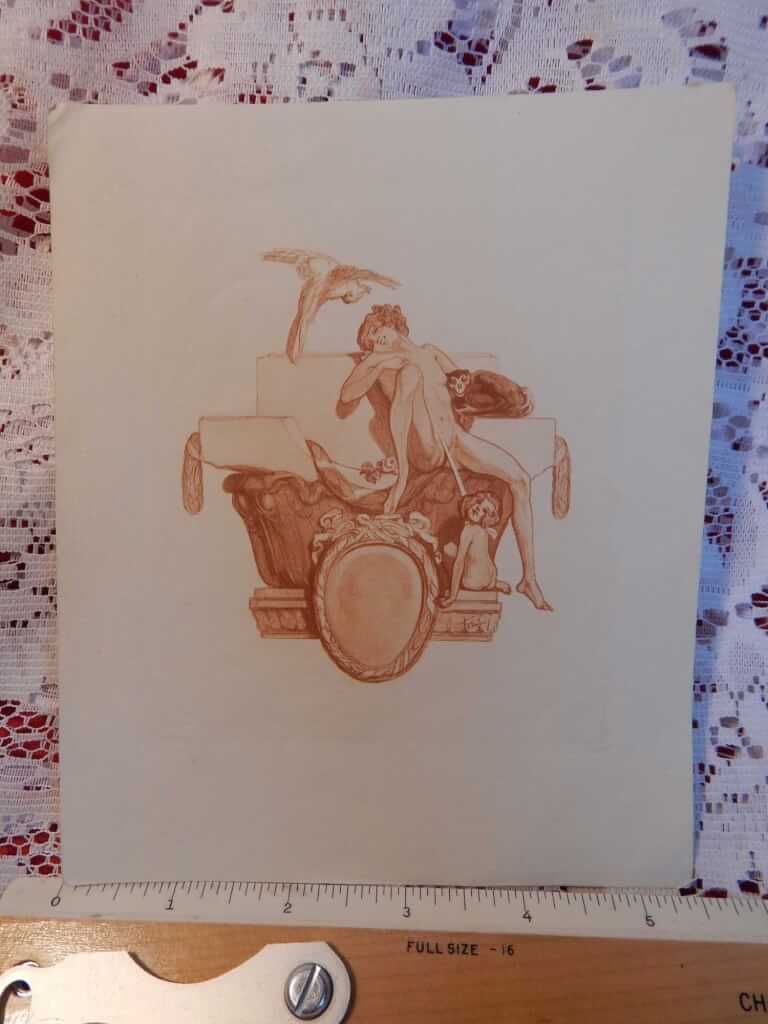 bookplate, by Franz von Bayros paper size 5.5 x 6.5", print size 4 x 4.5", on hand laid paper naked girl, animals, and child Franz von Bayros (1866 – 1924) was an Austrian commercial artist, illustrator, and painter, now he is best known for his erotic work. He belonged to the Decadent movement in art, often utilizing erotic themes and phantasmagoric imagery. At the age 17, Bayros passed the entrance exam for the Vienna Academy with Eduard von Engerth. Bayros mixed in elegant society and soon belonged to the circle of friends of Johann Straub, whose step daughter Alice he married on 1896. The next year, Bayros moved to Munich. In 1904, Bayros gave his first exhibition in Munich, which was a great success. From 1904 until 1908, Bayros traveled to Paris and Italy for his studies. Typically, for an artist dealing with such imagery, von Bayros produced work under several pseudonyms, most notably Choisy Le Conin, and was hounded by authorities for much of his life for his “indecent” art often very imaginative, and including such taboo subjects as sadomasochism and bestiality. He became equally well-known for his masterly drawn figures of elegant modestly nude and non-nude women.
bookplate, by Franz von Bayros paper size 5.5 x 6.5", print size 4 x 4.5", on hand laid paper naked girl, animals, and child Franz von Bayros (1866 – 1924) was an Austrian commercial artist, illustrator, and painter, now he is best known for his erotic work. He belonged to the Decadent movement in art, often utilizing erotic themes and phantasmagoric imagery. At the age 17, Bayros passed the entrance exam for the Vienna Academy with Eduard von Engerth. Bayros mixed in elegant society and soon belonged to the circle of friends of Johann Straub, whose step daughter Alice he married on 1896. The next year, Bayros moved to Munich. In 1904, Bayros gave his first exhibition in Munich, which was a great success. From 1904 until 1908, Bayros traveled to Paris and Italy for his studies. Typically, for an artist dealing with such imagery, von Bayros produced work under several pseudonyms, most notably Choisy Le Conin, and was hounded by authorities for much of his life for his “indecent” art often very imaginative, and including such taboo subjects as sadomasochism and bestiality. He became equally well-known for his masterly drawn figures of elegant modestly nude and non-nude women. -
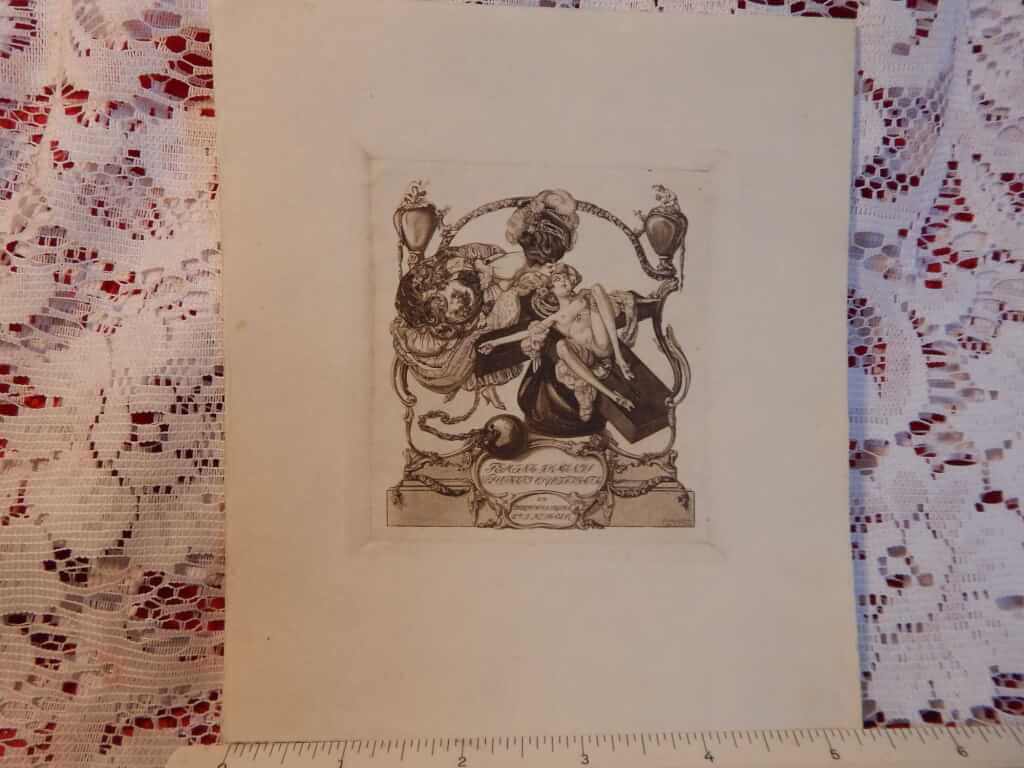 Femina Hominis Voluptati Crucifigata, Ex Bibliotheca Erotica Dr. J. Klueber, by Franz von Bayros paper size 5.5 x 6.25", print size 3.5 x 3.5" Topless handcuffed woman consoling naked girl nailed to cross. "Femina Hominis Voluptati Crucifigata" is possibly latin for "the woman is man's pleasure crucified"? The detail in this print is magnifying-glass-worthy as there are copulating couples at the top of the columns. Franz von Bayros (1866 – 1924) was an Austrian commercial artist, illustrator, and painter, now he is best known for his erotic work. He belonged to the Decadent movement in art, often utilizing erotic themes and phantasmagoric imagery. At the age 17, Bayros passed the entrance exam for the Vienna Academy with Eduard von Engerth. Bayros mixed in elegant society and soon belonged to the circle of friends of Johann Straub, whose step daughter Alice he married on 1896. The next year, Bayros moved to Munich. In 1904, Bayros gave his first exhibition in Munich, which was a great success. From 1904 until 1908, Bayros traveled to Paris and Italy for his studies. Typically, for an artist dealing with such imagery, von Bayros produced work under several pseudonyms, most notably Choisy Le Conin, and was hounded by authorities for much of his life for his “indecent” art often very imaginative, and including such taboo subjects as sadomasochism and bestiality. He became equally well-known for his masterly drawn figures of elegant modestly nude and non-nude women.
Femina Hominis Voluptati Crucifigata, Ex Bibliotheca Erotica Dr. J. Klueber, by Franz von Bayros paper size 5.5 x 6.25", print size 3.5 x 3.5" Topless handcuffed woman consoling naked girl nailed to cross. "Femina Hominis Voluptati Crucifigata" is possibly latin for "the woman is man's pleasure crucified"? The detail in this print is magnifying-glass-worthy as there are copulating couples at the top of the columns. Franz von Bayros (1866 – 1924) was an Austrian commercial artist, illustrator, and painter, now he is best known for his erotic work. He belonged to the Decadent movement in art, often utilizing erotic themes and phantasmagoric imagery. At the age 17, Bayros passed the entrance exam for the Vienna Academy with Eduard von Engerth. Bayros mixed in elegant society and soon belonged to the circle of friends of Johann Straub, whose step daughter Alice he married on 1896. The next year, Bayros moved to Munich. In 1904, Bayros gave his first exhibition in Munich, which was a great success. From 1904 until 1908, Bayros traveled to Paris and Italy for his studies. Typically, for an artist dealing with such imagery, von Bayros produced work under several pseudonyms, most notably Choisy Le Conin, and was hounded by authorities for much of his life for his “indecent” art often very imaginative, and including such taboo subjects as sadomasochism and bestiality. He became equally well-known for his masterly drawn figures of elegant modestly nude and non-nude women. -
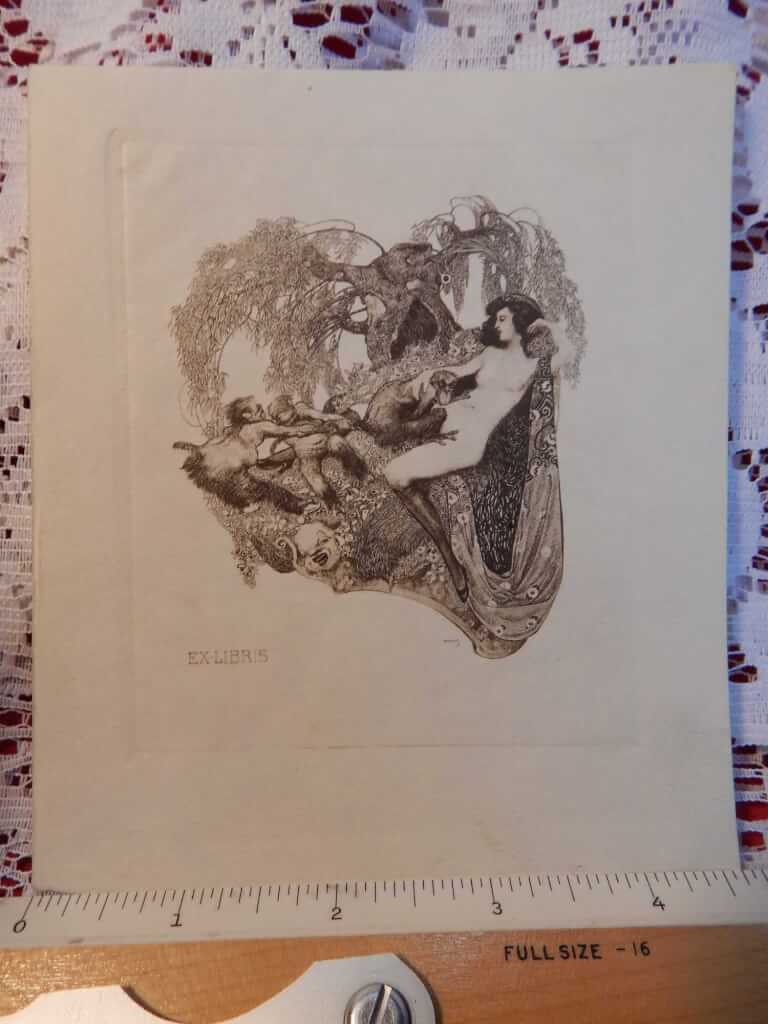 Ex Libris, by Franz von Bayros paper size 4.75 x 5.5", print size 3.5 x 4" naked woman sitting in a tree being "intimate" with monkey, other monkeys trying to pull him away from her. Very detailed and ornate. Franz von Bayros (1866 – 1924) was an Austrian commercial artist, illustrator, and painter, now he is best known for his erotic work. He belonged to the Decadent movement in art, often utilizing erotic themes and phantasmagoric imagery. At the age 17, Bayros passed the entrance exam for the Vienna Academy with Eduard von Engerth. Bayros mixed in elegant society and soon belonged to the circle of friends of Johann Straub, whose step daughter Alice he married on 1896. The next year, Bayros moved to Munich. In 1904, Bayros gave his first exhibition in Munich, which was a great success. From 1904 until 1908, Bayros traveled to Paris and Italy for his studies. Typically, for an artist dealing with such imagery, von Bayros produced work under several pseudonyms, most notably Choisy Le Conin, and was hounded by authorities for much of his life for his “indecent” art often very imaginative, and including such taboo subjects as sadomasochism and bestiality. He became equally well-known for his masterly drawn figures of elegant modestly nude and non-nude women.
Ex Libris, by Franz von Bayros paper size 4.75 x 5.5", print size 3.5 x 4" naked woman sitting in a tree being "intimate" with monkey, other monkeys trying to pull him away from her. Very detailed and ornate. Franz von Bayros (1866 – 1924) was an Austrian commercial artist, illustrator, and painter, now he is best known for his erotic work. He belonged to the Decadent movement in art, often utilizing erotic themes and phantasmagoric imagery. At the age 17, Bayros passed the entrance exam for the Vienna Academy with Eduard von Engerth. Bayros mixed in elegant society and soon belonged to the circle of friends of Johann Straub, whose step daughter Alice he married on 1896. The next year, Bayros moved to Munich. In 1904, Bayros gave his first exhibition in Munich, which was a great success. From 1904 until 1908, Bayros traveled to Paris and Italy for his studies. Typically, for an artist dealing with such imagery, von Bayros produced work under several pseudonyms, most notably Choisy Le Conin, and was hounded by authorities for much of his life for his “indecent” art often very imaginative, and including such taboo subjects as sadomasochism and bestiality. He became equally well-known for his masterly drawn figures of elegant modestly nude and non-nude women. -
Out of stock
 Nell in Bridewell (Lenchen im Zuchthause): Description of the System of Corporal Punishment (Flagellation) in the Female Prisons of South Germany up to the year 1848; a contribution to the history of manners., W. Reinhard, trans. W.C. Costello Ph. D. and A. R. Allinson M. A. (Psych Press [New York], 1932) 9 5/8" X 6 1/2", 326pp, hardbound, black cloth spine over orange cloth boards, gilt lettering and bands on spine, fore and bottom edge deckle, just good condition, soiling and rubbing on front cover, interior clean, some pages unopened, ex libris Joe H. and Bertha M. Shryock Although the title suggests that this is a "study", it goes beyond the facts and delves into the minds of those who are doing the punishing and those who are being humiliated and punished. Publishers of these "flagellation novels" would often lesson their liability by representing their books as academic studies. Often they would go unnoticed by the larger community unaware of the erotic nature of such a book to a certain segment of the public. In this book, Nell describes in graphic terms the merciless floggings she witnessed of girls and young women, as well as of boys and men and confesses to disturbingly confusing emotions that such sights occasioned in her. She recalls the lustful expressions on the faces of the onlookers, records the fervent words of gratitude to the skillful flogger from the lips of grand ladies who "were only too delighted to see such girls whipped", and tells of the evidently sensual appetites such cruelties incited in the torturers. This edition is a facsimile reprint of Carrington's 1900 translation. Added to it are very nice illustrations [woodcuts?] by an unknown artist.
Nell in Bridewell (Lenchen im Zuchthause): Description of the System of Corporal Punishment (Flagellation) in the Female Prisons of South Germany up to the year 1848; a contribution to the history of manners., W. Reinhard, trans. W.C. Costello Ph. D. and A. R. Allinson M. A. (Psych Press [New York], 1932) 9 5/8" X 6 1/2", 326pp, hardbound, black cloth spine over orange cloth boards, gilt lettering and bands on spine, fore and bottom edge deckle, just good condition, soiling and rubbing on front cover, interior clean, some pages unopened, ex libris Joe H. and Bertha M. Shryock Although the title suggests that this is a "study", it goes beyond the facts and delves into the minds of those who are doing the punishing and those who are being humiliated and punished. Publishers of these "flagellation novels" would often lesson their liability by representing their books as academic studies. Often they would go unnoticed by the larger community unaware of the erotic nature of such a book to a certain segment of the public. In this book, Nell describes in graphic terms the merciless floggings she witnessed of girls and young women, as well as of boys and men and confesses to disturbingly confusing emotions that such sights occasioned in her. She recalls the lustful expressions on the faces of the onlookers, records the fervent words of gratitude to the skillful flogger from the lips of grand ladies who "were only too delighted to see such girls whipped", and tells of the evidently sensual appetites such cruelties incited in the torturers. This edition is a facsimile reprint of Carrington's 1900 translation. Added to it are very nice illustrations [woodcuts?] by an unknown artist. -
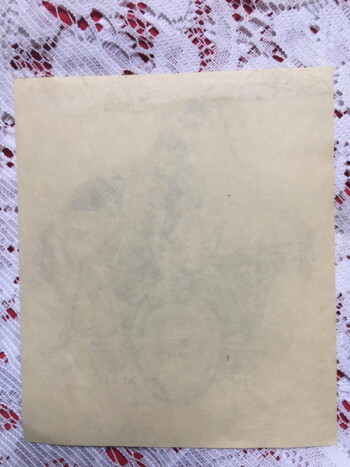
 Ex Libris H.E. McD, by Franz von Bayros 4 x 4.5" brown/black ink, previously pasted as evident by top part of back naked girl, animals, and child, presumably Ex libris for Horace E. McDonald Franz von Bayros (1866 – 1924) was an Austrian commercial artist, illustrator, and painter, now he is best known for his erotic work. He belonged to the Decadent movement in art, often utilizing erotic themes and phantasmagoric imagery. At the age 17, Bayros passed the entrance exam for the Vienna Academy with Eduard von Engerth. Bayros mixed in elegant society and soon belonged to the circle of friends of Johann Straub, whose step daughter Alice he married on 1896. The next year, Bayros moved to Munich. In 1904, Bayros gave his first exhibition in Munich, which was a great success. From 1904 until 1908, Bayros traveled to Paris and Italy for his studies. Typically, for an artist dealing with such imagery, von Bayros produced work under several pseudonyms, most notably Choisy Le Conin, and was hounded by authorities for much of his life for his “indecent” art often very imaginative, and including such taboo subjects as sadomasochism and bestiality. He became equally well-known for his masterly drawn figures of elegant modestly nude and non-nude women.
Ex Libris H.E. McD, by Franz von Bayros 4 x 4.5" brown/black ink, previously pasted as evident by top part of back naked girl, animals, and child, presumably Ex libris for Horace E. McDonald Franz von Bayros (1866 – 1924) was an Austrian commercial artist, illustrator, and painter, now he is best known for his erotic work. He belonged to the Decadent movement in art, often utilizing erotic themes and phantasmagoric imagery. At the age 17, Bayros passed the entrance exam for the Vienna Academy with Eduard von Engerth. Bayros mixed in elegant society and soon belonged to the circle of friends of Johann Straub, whose step daughter Alice he married on 1896. The next year, Bayros moved to Munich. In 1904, Bayros gave his first exhibition in Munich, which was a great success. From 1904 until 1908, Bayros traveled to Paris and Italy for his studies. Typically, for an artist dealing with such imagery, von Bayros produced work under several pseudonyms, most notably Choisy Le Conin, and was hounded by authorities for much of his life for his “indecent” art often very imaginative, and including such taboo subjects as sadomasochism and bestiality. He became equally well-known for his masterly drawn figures of elegant modestly nude and non-nude women. -

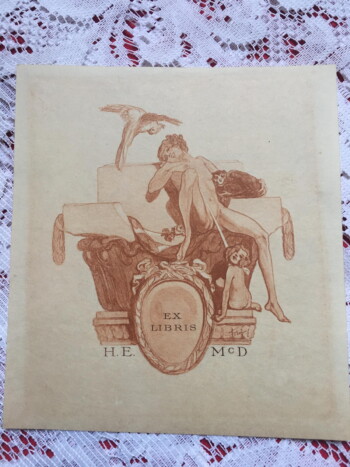 Ex Libris H.E. McD, by Franz von Bayros 4 x 4.5" red ink, previously pasted as evident by top part of back naked girl, animals, and child, presumably Ex libris for Horace E. McDonald Franz von Bayros (1866 – 1924) was an Austrian commercial artist, illustrator, and painter, now he is best known for his erotic work. He belonged to the Decadent movement in art, often utilizing erotic themes and phantasmagoric imagery. At the age 17, Bayros passed the entrance exam for the Vienna Academy with Eduard von Engerth. Bayros mixed in elegant society and soon belonged to the circle of friends of Johann Straub, whose step daughter Alice he married on 1896. The next year, Bayros moved to Munich. In 1904, Bayros gave his first exhibition in Munich, which was a great success. From 1904 until 1908, Bayros traveled to Paris and Italy for his studies. Typically, for an artist dealing with such imagery, von Bayros produced work under several pseudonyms, most notably Choisy Le Conin, and was hounded by authorities for much of his life for his “indecent” art often very imaginative, and including such taboo subjects as sadomasochism and bestiality. He became equally well-known for his masterly drawn figures of elegant modestly nude and non-nude women.
Ex Libris H.E. McD, by Franz von Bayros 4 x 4.5" red ink, previously pasted as evident by top part of back naked girl, animals, and child, presumably Ex libris for Horace E. McDonald Franz von Bayros (1866 – 1924) was an Austrian commercial artist, illustrator, and painter, now he is best known for his erotic work. He belonged to the Decadent movement in art, often utilizing erotic themes and phantasmagoric imagery. At the age 17, Bayros passed the entrance exam for the Vienna Academy with Eduard von Engerth. Bayros mixed in elegant society and soon belonged to the circle of friends of Johann Straub, whose step daughter Alice he married on 1896. The next year, Bayros moved to Munich. In 1904, Bayros gave his first exhibition in Munich, which was a great success. From 1904 until 1908, Bayros traveled to Paris and Italy for his studies. Typically, for an artist dealing with such imagery, von Bayros produced work under several pseudonyms, most notably Choisy Le Conin, and was hounded by authorities for much of his life for his “indecent” art often very imaginative, and including such taboo subjects as sadomasochism and bestiality. He became equally well-known for his masterly drawn figures of elegant modestly nude and non-nude women. -
Out of stock

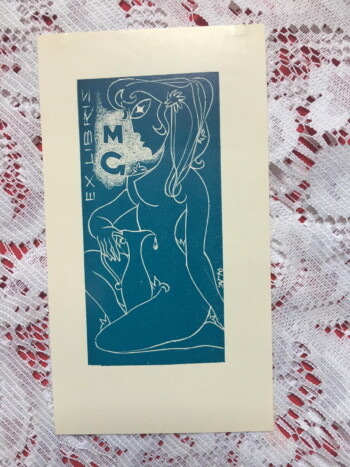 Ex Libris MG 2.75 x 5", unknown origin naked women with pitcher
Ex Libris MG 2.75 x 5", unknown origin naked women with pitcher -
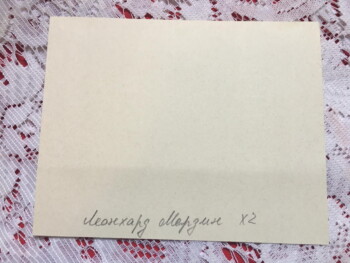
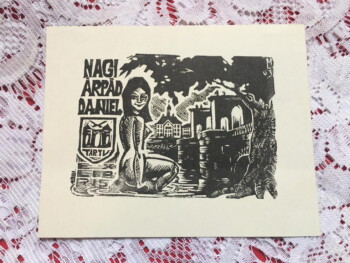 Ex Libris Nagi Arpad Daniel - Tartu 3.5 x 4.75", signed on the back, presumably by and for the Estonian artist, Arpad Daniel Nagy, Tartu is a city in Estonia nude woman sitting on rock in the water, behind her a bridge. Arpad Daniel Nagy was a creative visual artist. Arpad Daniel Nagy was born in 1922 and died in 1985. Arpad Daniel Nagy was largely inspired by the 1930s growing up. The period of the 1930s is characterised by the conflict between a number of political ideologies, including Marxist Socialism, Capitalist Democracy, and the Totalitarianism of both Communism and Fascism. Artistic output in the United States was heavily impacted at the time by the Great Depression, and a number of artists took to focusing on ideas of humility and the ordinary man. For the first time in US history, artists began to explore into political subjects and attempted to use their art to impact society. Themes such as poverty, lack of affordable housing, anti-lynching, anti-fascism, and workers' strikes were prevalent in many artists’ work. In the Soviet Union, Stalin’s government required urgent funds to implement the rapid industrialisation demanded by the first Five Year Plan. It initiated a secret plan to sell off treasures from the State Hermitage Museum in Leningrad (St. Petersburg), including a primary list of two hundred and fifty rare paintings by the Old Masters, many which found their way to the collection of Andrew Mellon via the New York based art dealing company, Knoedler. Surrealism continued to dominate in Europe, and had influence on an international scale. Artists such as Frida Kahlo and Diego Riviera in Mexico, worked to incorporate the ideas posed by Surrealism into their radical political ideologies, developing a new kind of magic realism. The decade took a ominous turn with the birth of National Socialism in Germany, followed by Adolf Hitler’s rise to power in 1933. By the end of the 1930s, the Second World War had begun; which preoccupied both artists and the global population.
Ex Libris Nagi Arpad Daniel - Tartu 3.5 x 4.75", signed on the back, presumably by and for the Estonian artist, Arpad Daniel Nagy, Tartu is a city in Estonia nude woman sitting on rock in the water, behind her a bridge. Arpad Daniel Nagy was a creative visual artist. Arpad Daniel Nagy was born in 1922 and died in 1985. Arpad Daniel Nagy was largely inspired by the 1930s growing up. The period of the 1930s is characterised by the conflict between a number of political ideologies, including Marxist Socialism, Capitalist Democracy, and the Totalitarianism of both Communism and Fascism. Artistic output in the United States was heavily impacted at the time by the Great Depression, and a number of artists took to focusing on ideas of humility and the ordinary man. For the first time in US history, artists began to explore into political subjects and attempted to use their art to impact society. Themes such as poverty, lack of affordable housing, anti-lynching, anti-fascism, and workers' strikes were prevalent in many artists’ work. In the Soviet Union, Stalin’s government required urgent funds to implement the rapid industrialisation demanded by the first Five Year Plan. It initiated a secret plan to sell off treasures from the State Hermitage Museum in Leningrad (St. Petersburg), including a primary list of two hundred and fifty rare paintings by the Old Masters, many which found their way to the collection of Andrew Mellon via the New York based art dealing company, Knoedler. Surrealism continued to dominate in Europe, and had influence on an international scale. Artists such as Frida Kahlo and Diego Riviera in Mexico, worked to incorporate the ideas posed by Surrealism into their radical political ideologies, developing a new kind of magic realism. The decade took a ominous turn with the birth of National Socialism in Germany, followed by Adolf Hitler’s rise to power in 1933. By the end of the 1930s, the Second World War had begun; which preoccupied both artists and the global population. -
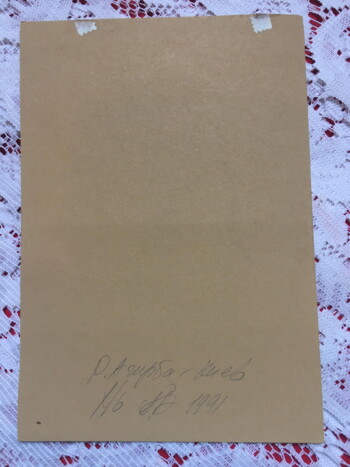
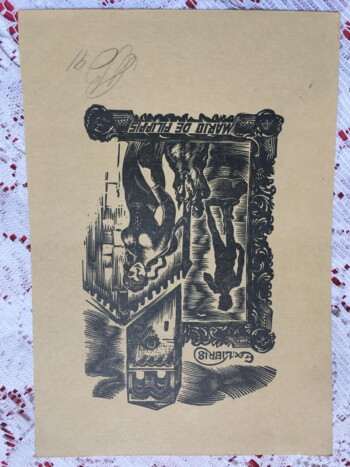 Ex Libris Mario de Filippis (signed) 5 x 4", signed on the front and back in pencil, presumably by artist Woman, man on horseback in front of Italian architecture and a silhouette of Michelangelo's David One of the most important (and largest) collections of ex libris in the world belongs to Mario De Filippis, the owner of Buca di San Francesco restaurant in Arezzo Italy. He has over 130,000 ex libris in his collection, approximately 13,000 are personal ex libris plates he's commissioned from artists all over the world using a multitude of printing techniques. His website describes Mario as "a passionate lover of small graphics".
Ex Libris Mario de Filippis (signed) 5 x 4", signed on the front and back in pencil, presumably by artist Woman, man on horseback in front of Italian architecture and a silhouette of Michelangelo's David One of the most important (and largest) collections of ex libris in the world belongs to Mario De Filippis, the owner of Buca di San Francesco restaurant in Arezzo Italy. He has over 130,000 ex libris in his collection, approximately 13,000 are personal ex libris plates he's commissioned from artists all over the world using a multitude of printing techniques. His website describes Mario as "a passionate lover of small graphics". -
 The Ragionamenti or dialogues of the devine Pietro Aretino, Pietro Aretino, trans. Isidore Liseux (Isidore Liseux, Paris, 1889) 8" X 6", 3 volumes, xxxv+83+89pp, 100+134pp, 129+138pp, half-bound brown morocco over marbled boards, gilt titles on spines, top-edge gilt, other edges deckled, each book has the ex-libris of Boies Penrose II Pietro Aretino (1492-1556) was one of the most important figures in Italian Renaissance literature, and certainly the most controversial. Condemned by some as a pornographer, his infamy was due largely to his use of explicit sexuality and the vulgar tongue of ordinary speech in much of his work. Dialogues center around a conversation between two rather frank, experienced, and sharp-tongued women on the topic of women’s occupations. We learn that at the time there were only three: wife, whore, or nun. Their discussion is a rollicking account of the advantages, perils, and pleasures each profession offers. Not only was Dialogues the first erotic book in the Christian world to be written in the common vernacular, it was but one of the few to describe the obscenity of commercial love, and is thus a cornerstone of both Italian literature and Counter-Renaissance vigour. First dialog: The Life of Nuns Second dialog: The Life of Married Women Third dialog: The Life of Courtesans Fourth dialog: The Education of Pippa Fifth dialog: The Wiles of Men Sixth dialog: The Bawd’s Trade Isidore Liseux (1835-1894) was a French bibliophile and publisher of erotica and curiosa. His publications were mostly rare texts of 16th to 18th century authors, hard to find and little known books which were usually translated and annotated by his friend and associate Alcide Bonneau or by Liseux himself. Liseux and Bonneau, both ex-priests, knew each other since seminary. His books were published in small numbers, on high quality paper, and with excellent typography. His usual printers were Claude Motteroz, Antoine Bécus, and later Charles Unsinger. Liseux’s books were published openly as the climate was more permissive in Paris at the time. His books were so well regarded that pirates of his books and even unrelated books bearing his imprint with a false date were published clandestinely into the 20th century. French poet, Guillaume Apollinaire wrote: “The publications of Liseux are more and more sought after because they are correct, beautiful and rare.” (Le flaneur des deux rives, 1918). Time Magazine, Monday, May 11, 1936 Youngish Pennsylvanians whose Progressive fathers frightened them with the name of BOIES PENROSE a quarter century ago could look forward last week to bemusing their own children with that great name some day. In Philadelphia Boies Penrose II, nephew of Pennsylvania's longtime (1897-1921) Senator and Republican boss, received a Republican nomination to Congress in last week's primary. A rich and cultured Harvard man like his late uncle, 34-year-old Boies II has hitherto devoted himself to scholarship and society, is the owner of a notable collection of etchings, engravings, manuscripts and rare books. When he decided few months ago to make a career for himself in politics, leaders of Philadelphia's Republican machine warmly welcomed a young man with so potent a name, so fat a pocketbook. Candidate Penrose, who owns a 125-acre estate on the Main Line at swank Devon where he takes his own and neighbors' small children for rides on his mile-long miniature railroad, promptly established a residence in Philadelphia by renting an apartment, the address of which he is constantly forgetting.— "My platform," he announced in fastidious Bostonese, "will be the Horse & Buggy, or Save the Constitution." In the Republican split of 1912 Boies Penrose temporarily lost his State leadership to the Bull Moose faction, which included an ardent Young Roosevelt worshipper named Gifford Pinchot. While one set of Philadelphia voters was lifting the name of Penrose up last week, another group was setting the name of Pinchot down. In a district inhabited largely by factory workers whose cause she has championed many a time on the picket line, red-haired Mrs. Gifford Pinchot made her third race for a Republican nomination to the House, suffered her third defeat.
The Ragionamenti or dialogues of the devine Pietro Aretino, Pietro Aretino, trans. Isidore Liseux (Isidore Liseux, Paris, 1889) 8" X 6", 3 volumes, xxxv+83+89pp, 100+134pp, 129+138pp, half-bound brown morocco over marbled boards, gilt titles on spines, top-edge gilt, other edges deckled, each book has the ex-libris of Boies Penrose II Pietro Aretino (1492-1556) was one of the most important figures in Italian Renaissance literature, and certainly the most controversial. Condemned by some as a pornographer, his infamy was due largely to his use of explicit sexuality and the vulgar tongue of ordinary speech in much of his work. Dialogues center around a conversation between two rather frank, experienced, and sharp-tongued women on the topic of women’s occupations. We learn that at the time there were only three: wife, whore, or nun. Their discussion is a rollicking account of the advantages, perils, and pleasures each profession offers. Not only was Dialogues the first erotic book in the Christian world to be written in the common vernacular, it was but one of the few to describe the obscenity of commercial love, and is thus a cornerstone of both Italian literature and Counter-Renaissance vigour. First dialog: The Life of Nuns Second dialog: The Life of Married Women Third dialog: The Life of Courtesans Fourth dialog: The Education of Pippa Fifth dialog: The Wiles of Men Sixth dialog: The Bawd’s Trade Isidore Liseux (1835-1894) was a French bibliophile and publisher of erotica and curiosa. His publications were mostly rare texts of 16th to 18th century authors, hard to find and little known books which were usually translated and annotated by his friend and associate Alcide Bonneau or by Liseux himself. Liseux and Bonneau, both ex-priests, knew each other since seminary. His books were published in small numbers, on high quality paper, and with excellent typography. His usual printers were Claude Motteroz, Antoine Bécus, and later Charles Unsinger. Liseux’s books were published openly as the climate was more permissive in Paris at the time. His books were so well regarded that pirates of his books and even unrelated books bearing his imprint with a false date were published clandestinely into the 20th century. French poet, Guillaume Apollinaire wrote: “The publications of Liseux are more and more sought after because they are correct, beautiful and rare.” (Le flaneur des deux rives, 1918). Time Magazine, Monday, May 11, 1936 Youngish Pennsylvanians whose Progressive fathers frightened them with the name of BOIES PENROSE a quarter century ago could look forward last week to bemusing their own children with that great name some day. In Philadelphia Boies Penrose II, nephew of Pennsylvania's longtime (1897-1921) Senator and Republican boss, received a Republican nomination to Congress in last week's primary. A rich and cultured Harvard man like his late uncle, 34-year-old Boies II has hitherto devoted himself to scholarship and society, is the owner of a notable collection of etchings, engravings, manuscripts and rare books. When he decided few months ago to make a career for himself in politics, leaders of Philadelphia's Republican machine warmly welcomed a young man with so potent a name, so fat a pocketbook. Candidate Penrose, who owns a 125-acre estate on the Main Line at swank Devon where he takes his own and neighbors' small children for rides on his mile-long miniature railroad, promptly established a residence in Philadelphia by renting an apartment, the address of which he is constantly forgetting.— "My platform," he announced in fastidious Bostonese, "will be the Horse & Buggy, or Save the Constitution." In the Republican split of 1912 Boies Penrose temporarily lost his State leadership to the Bull Moose faction, which included an ardent Young Roosevelt worshipper named Gifford Pinchot. While one set of Philadelphia voters was lifting the name of Penrose up last week, another group was setting the name of Pinchot down. In a district inhabited largely by factory workers whose cause she has championed many a time on the picket line, red-haired Mrs. Gifford Pinchot made her third race for a Republican nomination to the House, suffered her third defeat.

